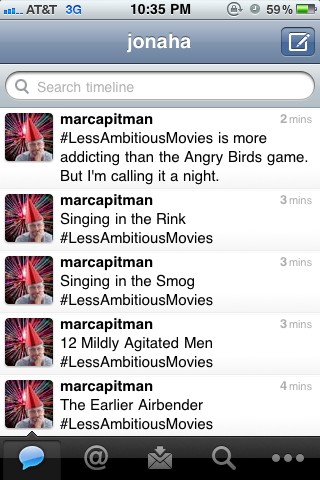 A few weeks ago, a Twitter hashtag, #lessambitiousmovies, caught my attention. It was around 10:30 p.m. after a hard day and I had a blast coming up with appropriate movie titles. Apparently I tweeted alot in 30 minutes! @jonaha sent me this screenshot. I’d totally dominated her stream!
A few weeks ago, a Twitter hashtag, #lessambitiousmovies, caught my attention. It was around 10:30 p.m. after a hard day and I had a blast coming up with appropriate movie titles. Apparently I tweeted alot in 30 minutes! @jonaha sent me this screenshot. I’d totally dominated her stream!
The next day, I got an email from someone letting me know that, despite 3 years of informative and valuable tweets, those 30 minutes overwhelmed him so much he was unfollowing me.
First of all, I’m sure people unfollow me every day. Twitter is so fluid that people are coming and going all the time. Fortunately more people find me interesting than people that don’t. It amazes me that this one person thought I’d notice his unfollowing me. I really don’t pay attention to the “unfollows” and don’t get why people would. I try to only follow people that I find value from so I expect people to do the same with me.
Social media needs to be personal. It is “social”! People want to connect with people, not with faceless institutions. So it’s good to be personal, even quirky, in your social media communications.
But how personal should your nonprofit account be? That depends on your organizational culture. If your culture is quirky and fun, people will expect that in your communication.
But what if your culture is stuffy or more formal? Here are some ways to communicate personally without violating your culture:
- Let your employees have their own Twitter accounts. Maybe their name with your organizations name. @lionelatdell is a great corporate example of this. This allows them to identify themselves as affiliated with your organization but still speak in their own voice.
- Encourage employees to make comments on your Facebook page without them being admins. That way their faces will show instead of your organization’s logo.
- If they do communicate from the official account, let them put a ^ and their initials. If I were to tweet something from a nonprofit account, I could add ^mp to let people know a real person was behind the tweet.
None of these are foolproof. When it comes to social media, you’ll need to be open to letting your employees make mistakes. [But please learn from the Honda Crosstour failure: if someone is an employee of the company, be upfront about it!] Social media is much more transparent than other media and people will call you out on it. It’s so important to be authentic.
Would I do this sort of thing from my account again? Most definitely. Every time I participate in one of these memes, I meet people I haven’t known. And I find fun sides to people I’ve already been in contact with.
Would I do the #lessambitiousmovies from an organizational account? Probably not. But if the organization were movie related, even tangentially, that might be a great way to engage fans.





I’m trying to find that balance as well. No one wants to follow a Twitter account that’s all business, all the time. There’s obviously a person behind it all, and that person has real experiences and emotions.
I get a daily newsletter from SteepandCheap.com, an outdoors gear site. They have a funny or insightful mini-blog post in each email. I would have subscribed to the emails a long time ago, but I enjoy the personal touch.
Thanks for your post!
@Fundly
Coincidentally I was just publicly called out for having the audacity to tweet five times in an hour! I think the very fluidity that you mentioned, Marc, makes Twitter a social medium. I owe this motto to Rick Nelson: You can’t please everyone, so you’ve got to please yourself.
Really? Someone would “call you out” for communicating? I don’t get that. Why in the world were they counting?
Thanks for sharing, Pamela! (And thank you for your tweets–even multiple ones per hour!)
Thanks for a thoughtful and practical post on making social media communications personal while still being respectful of organizational culture.
When I think about the people and organizations I follow regularly, it is their personality or “feel” that draws me in combined with great content.
Pamela Grow is a great example of someone that I’ve followed for her knowledge, humor and willingness to take a stand (even if it is on the benefits of running or using Himalayan pink salt in cookies!)
I agree with you. I don’t care who unfollows me – I only care who follows that I like and want to follow back!
I also laugh when I see someone with 5-figure followers and 3 figure or less tweets? HELLO?
Do you really think you’re fooling anyone with whatever nonsense program where you get numbers but no one you know or care about? I actually screen ALL my followers and write and say “Hi” to nearly ALL of them as well.
When I soon hit 5,000 followers, I can honestly say they are REAL and cool!
Bruce: Glad to be one of those followers. 🙂